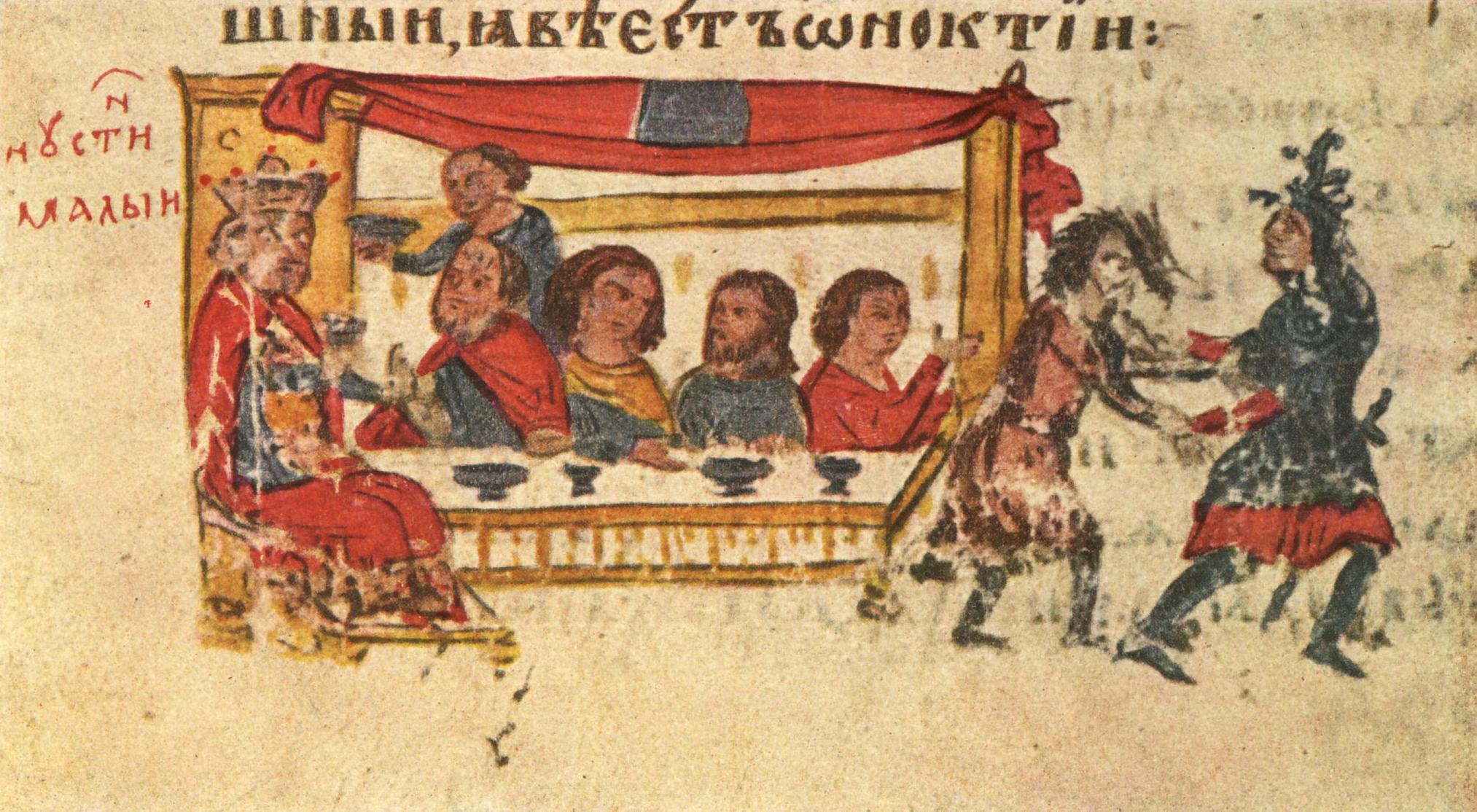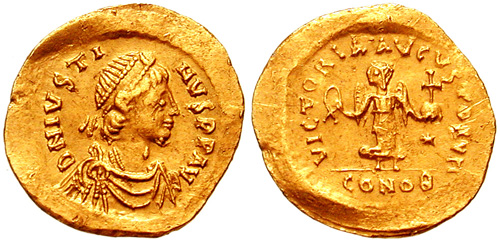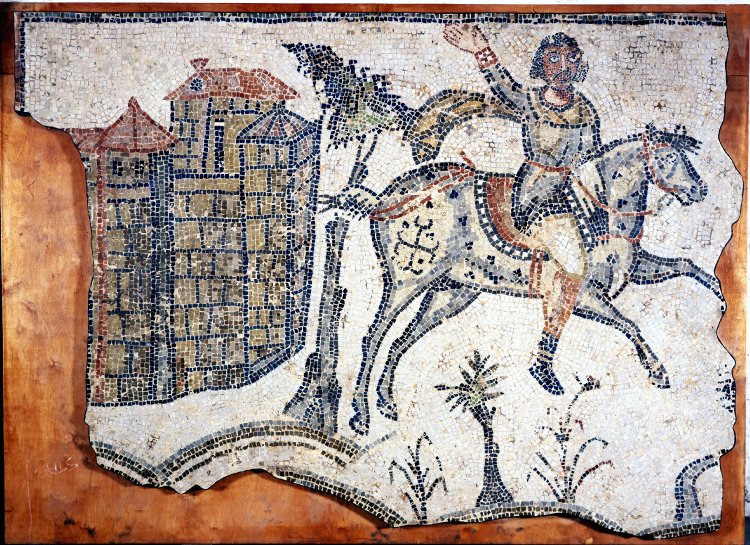|
Justin II
Justin II ( la, Iustinus; grc-gre, Ἰουστῖνος, Ioustînos; died 5 October 578) or Justin the Younger ( la, Iustinus minor) was Eastern Roman Emperor from 565 until 578. He was the nephew of Justinian I and the husband of Sophia, the niece of the Empress Theodora, and was therefore a member of the Justinian dynasty. Justin II inherited a greatly enlarged but overextended empire, with far less resources at his disposal compared to Justinian I. Despite this, he strived to match his formidable uncle's reputation by abandoning the payment of tributes to the Empire's neighbors. This miscalculated move resulted in rekindling of war with the Sassanid Empire, and in a Lombard invasion which cost the Romans much of their territory in Italy. Family He was a son of Vigilantia and Dulcidio (sometimes rendered as Dulcissimus), respectively the sister and brother-in-law of Justinian. His siblings included Marcellus and Praejecta. With Sophia he had a daughter Arabia and possibly ... [...More Info...] [...Related Items...] OR: [Wikipedia] [Google] [Baidu] |
Solidus (coin)
The ''solidus'' (Latin 'solid'; ''solidi'') or nomisma ( grc-gre, νόμισμα, ''nómisma'', 'coin') was a highly pure gold coin issued in the Late Roman Empire and Byzantine Empire. Constantine I, Constantine introduced the coin, and its weight of about 4.5 grams remained relatively constant for seven centuries. In the Byzantine Empire, the solidus or nomisma remained a highly pure gold coin until the 11th century, when several Byzantine Empire, Byzantine list of Byzantine emperors, emperors began to strike the coin with less and less gold. The nomisma was finally abolished by Alexius I in 1092, who replaced it with the hyperpyron, which also came to be known as a "bezant". The Byzantine solidus also inspired the originally slightly less pure Dinar (coin), dinar issued by the Muslim Caliphate. In Western Europe, the solidus was the main gold coin of commerce from late Roman times to Pepin the Short's Carolingian Renaissance#Carolingian currency, currency reform, wh ... [...More Info...] [...Related Items...] OR: [Wikipedia] [Google] [Baidu] |
Augustus (honorific)
''Augustus'' (plural ''Augusti''; , ; "majestic", "great" or "venerable") was an ancient Roman title given as both name and title to Gaius Julius Caesar Octavianus (often referred to simply as Augustus), Rome's first Emperor. On his death, it became an official title of his successor, and was so used by Roman emperors thereafter. The feminine form '' Augusta'' was used for Roman empresses and other female members of the Imperial family. The masculine and feminine forms originated in the time of the Roman Republic, in connection with things considered divine or sacred in traditional Roman religion. Their use as titles for major and minor Roman deities of the Empire associated the Imperial system and Imperial family with traditional Roman virtues and the divine will, and may be considered a feature of the Roman Imperial cult. In Rome's Greek-speaking provinces, "Augustus" was translated as ''Sebastos'' (Σεβαστός, "venerable"), or Hellenised as ''Augoustos'' (); these titl ... [...More Info...] [...Related Items...] OR: [Wikipedia] [Google] [Baidu] |
Sassanid Empire
The Sasanian () or Sassanid Empire, officially known as the Empire of Iranians (, ) and also referred to by historians as the Neo-Persian Empire, was the last Iranian empire before the early Muslim conquests of the 7th-8th centuries AD. Named after the House of Sasan, it endured for over four centuries, from 224 to 651 AD, making it the longest-lived Persian imperial dynasty. The Sasanian Empire succeeded the Parthian Empire, and re-established the Persians as a major power in late antiquity alongside its neighbouring arch-rival, the Roman Empire (after 395 the Byzantine Empire).Norman A. Stillman ''The Jews of Arab Lands'' pp 22 Jewish Publication Society, 1979 International Congress of Byzantine Studies ''Proceedings of the 21st International Congress of Byzantine Studies, London, 21–26 August 2006, Volumes 1–3'' pp 29. Ashgate Pub Co, 2006 The empire was founded by Ardashir I, an Iranian ruler who rose to power as Parthia weakened from internal strife and wars with th ... [...More Info...] [...Related Items...] OR: [Wikipedia] [Google] [Baidu] |
Justinian Dynasty
The Byzantine Empire had its first golden age under the Justinian dynasty, which began in 518 AD with the accession of Justin I. Under the Justinian dynasty, particularly the reign of Justinian I, the empire reached its greatest territorial extent since the fall of its Western counterpart, reincorporating North Africa, southern Illyria, southern Spain, and Italy into the empire. The Justinian dynasty ended in 602 with the deposition of Maurice and the ascension of his successor, Phocas. Justin I Early life and accession to the throne The Justinian dynasty began with the accession of its namesake Justin I to the throne. Justin I was born in a big village, Bederiana, in the 450s CE. Like many country youths, he went to Constantinople and enlisted in the army, where, due to his physical abilities, he became a part of the Excubitors, the palace guards. He fought in the Isaurian and Persian wars, and rose through the ranks to become the commander of the Excubitors, which was a ... [...More Info...] [...Related Items...] OR: [Wikipedia] [Google] [Baidu] |
Theodora (6th Century)
Theodora (; Greek: Θεοδώρα; 50028 June 548), sometimes enumerated as Theodora I, was Byzantine empress by marriage to emperor Justinian. She became empress upon Justinian's accession in 527 and had commanding or considerable influence over him; she was his most trusted adviser in directing all things pertaining to the empire and the terms of appointing and dismissing anyone in the empire. As empress, she had deep influence on the religious values of the time and played a key role in reforming the treatment and status of women within the Byzantine Empire. Along with her spouse, Theodora is a saint in the Eastern Orthodox Church and in the Oriental Orthodox Church, commemorated on 14 November and 28 June respectively. Certain researchers have opined that she was the most powerful and influential woman in Byzantine history. Historiography The main historical sources for her life are the works of her contemporary Procopius. Procopius was a member of the staff of Belisarius, ... [...More Info...] [...Related Items...] OR: [Wikipedia] [Google] [Baidu] |
Sophia (empress)
Aelia Sophia (Medieval Greek: Σοφία) (c. 530 – c./aft. 601) was the Byzantine empress as the wife of Emperor Justin II. She was also ruler in her capacity as regent during the incapacity of her spouse from 573 until 578, though she was never a monarch. She was interested in economic and financial matters during Justin's reign. Early life According to the ''Ecclesiastic History'' of John of Ephesus, Sophia was a niece of Theodora, the Empress consort of Justinian I. John of Ephesus did not specify the identities of her parents. According to the Secret History of Procopius, Theodora had only two siblings: her older sister Comito and younger sister Anastasia; either one could be the mother of Sophia. Procopius identifies Comito as a leading hetaera of her age. John Malalas records that Comito (b. ca 500) married general Sittas in 528.PLRE, vol. 3, ''Sittas'' Sittas may thus be the father of Sophia. Whether Anastasia ever married is unknown. During the reign of Justinian I (52 ... [...More Info...] [...Related Items...] OR: [Wikipedia] [Google] [Baidu] |
Eastern Roman Emperor
This is a list of the Byzantine emperors from the foundation of Constantinople in 330 AD, which marks the conventional start of the Eastern Roman Empire, to its fall to the Ottoman Empire in 1453 AD. Only the emperors who were recognized as legitimate rulers and exercised sovereign authority are included, to the exclusion of junior co-emperors (''symbasileis'') who never attained the status of sole or senior ruler, as well as of the various usurpers or rebels who claimed the imperial title. The following list starts with Constantine the Great, the first Christian emperor, who rebuilt the city of Byzantium as an imperial capital, Constantinople, and who was regarded by the later emperors as the model ruler. It was under Constantine that the major characteristics of what is considered the Byzantine state emerged: a Roman polity centered at Constantinople and culturally dominated by the Greek East, with Christianity as the state religion. The Byzantine Empire was the direct lega ... [...More Info...] [...Related Items...] OR: [Wikipedia] [Google] [Baidu] |
Vandalic War
The Vandalic War was a conflict fought in North Africa between the forces of the Byzantine Empire and the Vandal Kingdom, Vandalic Kingdom of Carthage in 533–534. It was the first of Justinian I's wars of reconquest of the Western Roman Empire. The Vandals occupied Roman North Africa in the early 5th century, and established an independent kingdom there. Under their king, Geiseric, the Vandal navy carried out pirate attacks across the Mediterranean, Sack of Rome (455), sacked Rome and defeated a Roman invasion in 468. After Geiseric's death, relations with the Eastern Roman Empire normalized, although tensions flared up occasionally due to the Vandals' adherence to Arianism and their persecution of the Nicene native population. In 530, a palace coup in Carthage overthrew the pro-Roman Hilderic and replaced him with his cousin Gelimer. The Eastern Roman emperor Justinian took this as a pretext to intervene in Vandal affairs, and after securing the eastern frontier with Sassani ... [...More Info...] [...Related Items...] OR: [Wikipedia] [Google] [Baidu] |
Vandals
The Vandals were a Germanic peoples, Germanic people who first inhabited what is now southern Poland. They established Vandal Kingdom, Vandal kingdoms on the Iberian Peninsula, Mediterranean islands, and North Africa in the fifth century. The Vandals migrated to the area between the lower Oder and Vistula rivers in the second century BC and settled in Silesia from around 120 BC. They are associated with the Przeworsk culture and were possibly the same people as the Lugii. Expanding into Roman Dacia, Dacia during the Marcomannic Wars and to Pannonia during the Crisis of the Third Century, the Vandals were confined to Pannonia by the Goths around 330 AD, where they received permission to settle from Constantine the Great. Around 400, raids by the Huns from the east forced many Germanic tribes to migrate west into the territory of the Roman Empire and, fearing that they might be targeted next, the Vandals were also pushed westwards, Crossing of the Rhine, crossing the Rhine in ... [...More Info...] [...Related Items...] OR: [Wikipedia] [Google] [Baidu] |
Antae
The Antes, or Antae ( gr, Ἄνται), were an early East Slavic tribal polity of the 6th century CE. They lived on the lower Danube River, in the northwestern Black Sea region (present-day Moldova and central Ukraine), and in the regions around the Don River (in Middle and Southern Russia). Scholars commonly associate the Antes with the archaeological Penkovka culture. First mentioned in the historical record in 518, the Antes invaded the Diocese of Thrace sometime between the years of 533 and 545. Thereafter, they became Byzantine ''foederati'' and received gold payments and a fort (named "Turris" - the Latin word ''turris'' means 'tower') somewhere north of the Danube at a strategically important location to prevent hostile barbarians from invading Roman lands. Thus from 545 to the 580s, Antean soldiers fought in various Byzantine campaigns. The Pannonian Avars attacked the Antes at the beginning of the 7th century, when the Antes disappeared as a group and became ancestor ... [...More Info...] [...Related Items...] OR: [Wikipedia] [Google] [Baidu] |
Ancient Germans
The Germanic peoples were historical groups of people that once occupied Central Europe and Scandinavia during antiquity and into the early Middle Ages. Since the 19th century, they have traditionally been defined by the use of ancient and early medieval Germanic languages and are thus equated at least approximately with Germanic-speaking peoples, although different academic disciplines have their own definitions of what makes someone or something "Germanic". The Romans named the area belonging to North-Central Europe in which Germanic peoples lived ''Germania'', stretching East to West between the Vistula and Rhine rivers and north to south from Southern Scandinavia to the upper Danube. In discussions of the Roman period, the Germanic peoples are sometimes referred to as ''Germani'' or ancient Germans, although many scholars consider the second term problematic since it suggests identity with present-day Germans. The very concept of "Germanic peoples" has become the subject of ... [...More Info...] [...Related Items...] OR: [Wikipedia] [Google] [Baidu] |
Franks
The Franks ( la, Franci or ) were a group of Germanic peoples whose name was first mentioned in 3rd-century Roman sources, and associated with tribes between the Lower Rhine and the Ems River, on the edge of the Roman Empire.H. Schutz: Tools, Weapons and Ornaments: Germanic Material Culture in Pre-Carolingian Central Europe, 400-750. BRILL, 2001, p.42. Later the term was associated with Romanized Germanic dynasties within the collapsing Western Roman Empire, who eventually commanded the whole region between the rivers Loire and Rhine. They imposed power over many other post-Roman kingdoms and Germanic peoples. Beginning with Charlemagne in 800, Frankish rulers were given recognition by the Catholic Church as successors to the old rulers of the Western Roman Empire. Although the Frankish name does not appear until the 3rd century, at least some of the original Frankish tribes had long been known to the Romans under their own names, both as allies providing soldiers, and as e ... [...More Info...] [...Related Items...] OR: [Wikipedia] [Google] [Baidu] |



.jpg)




